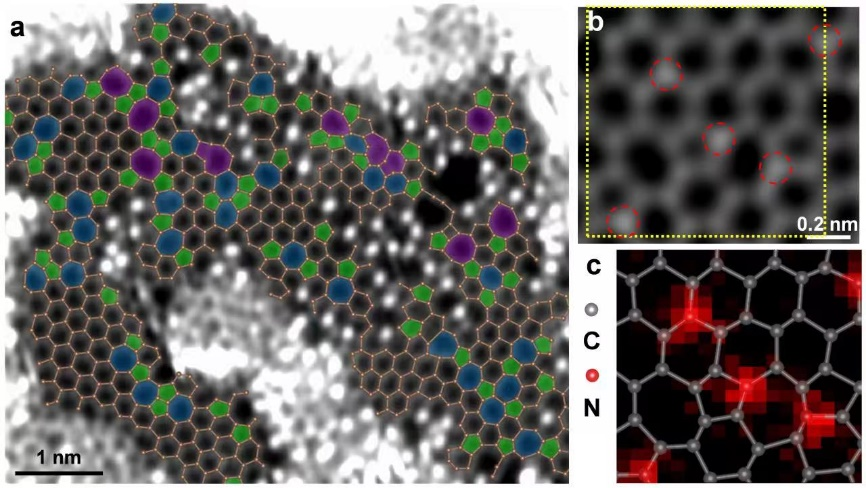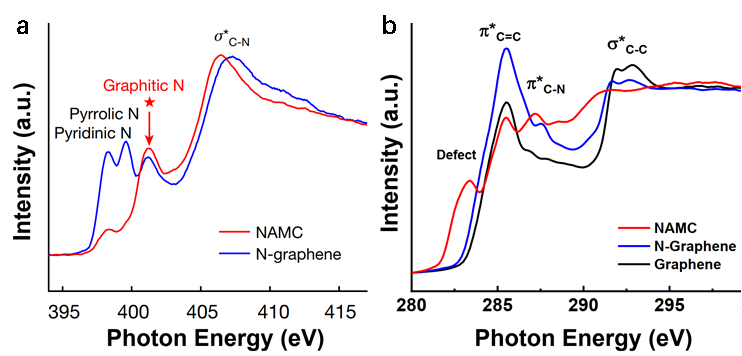Users of HLS made a major breakthrough in the field of two-dimensional amorphous material synthesis
Recently, Professor Lin Guo from Beihang University and collaborators have made a significant breakthrough in the controlled synthesis of two-dimensional amorphous materials. The related research findings were published in the top international journal Nature on September 25, 2024, under the title Nitrogen-doped amorphous monolayer carbon. Amorphous materials possess a long-range disordered atomic structure, endowing them with physical and chemical properties distinctly different from crystalline materials, leading to broad applications in catalysis, optics, electronics, and other fields. However, the analysis of atomic-scale structure and the structure-property relationships in amorphous materials remains one of the most challenging problems in condensed matter physics. Theoretically, single-atom-layer amorphous materials provide an ideal model system for studying amorphous physics. Analyzing their structure and characteristics is crucial for a deeper understanding of the relationships between the structure, degree of disorder, and properties of amorphous substances, thereby advancing the field of condensed matter physics. Nevertheless, challenges such as the precise control of long-range disorder, thermodynamic stability, and the degree of reaction space confinement pose significant obstacles to the controlled synthesis of single-atom-layer amorphous materials. Addressing the long-standing challenges in the synthesis of 2D amorphous materials, the research team proposed a liquid-phase synthesis strategy utilizing nanoscale 2D confinement templates for small molecule polymerization. They successfully synthesized nitrogen-doped amorphous monolayer carbon (NAMC). The team used layered double hydroxide (LDH) nanosheets as templates, whose confinement effect inhibited three-dimensional rotation and entanglement during molecular polymerization. Consequently, polymerization occurred within the 2D plane. This approach broke through the limitation of traditional pyrrole polymerization, which is confined to α-C site crosslinking, and promoted crosslinking polymerization at β-C and N sites. This process ultimately resulted in the formation of a 2D amorphous planar network structure coexisting with five-, six-, and seven-membered rings. The research team precisely mapped the distribution of carbon and nitrogen atoms within the 2D amorphous carbon network, confirming the incorporation of nitrogen atoms into the 2D topological network mixed with five-, six-, and seven-membered rings, achieving a nitrogen doping concentration of up to 9%.

Figure 1. Nitrogen doped single atomic layer amorphous carbon
The research team utilized the soft X-ray absorption spectroscopy (sXAS) at the photoemission end-station (BL10B) of National Synchrotron Radiation Laboratory (NSRL) to characterize the synthesized NAMC. The C-K-edge absorption spectrum (NEXAFS) of NAMC revealed the presence of sp²-hybridized carbon (285.5 eV) as well as topological structures containing five-membered and seven-membered rings (283.4 eV). Simultaneously, the N-K-edge absorption spectrum exhibited a resonance peak for graphitic N (401.2 eV), a weak peak for pyridinic N (398.3 eV), and a weak shoulder peak for pyrrolic N (399.6 eV), indicating that nitrogen atoms within the two-dimensional amorphous carbon network primarily exist in the graphitic N configuration, with minor amounts of pyridinic N and pyrrolic N also present. The soft X-ray absorption spectroscopy results confirm the fundamental mesh structure of NAMC, clarify the chemical states of carbon and nitrogen within it, and provide crucial experimental evidence for further refining and optimizing this synthesis strategy.

Figure 2. N-K edge absorption spectra (a) and C-K edge absorption spectra (b) of nitrogen doped single atomic layer amorphous carbon
Subsequently, the nanoscale two-dimensional confinement synthesis strategy was successfully applied to the preparation of single-layer amorphous carbon materials with other heteroatoms, demonstrating its universality and providing a new research direction for the development of high-performance two-dimensional amorphous materials in the future.
This study was conducted with the support of the Hefei Light Source Photoemission End-Station (BL10B) and the Soft X-ray Magnetic Circular Dichromatic Beam Line Station (BL12B).
Paper link:https://www.nature.com/articles/s41586-025-08630-x
Back
